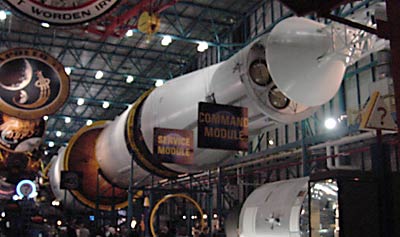Restoring the wonderby Anthony Young
|
| What inspires wonder to motivate current and future generations to explore our universe? |
America not only did brilliantly, it accomplished it on schedule. More than three decades later, Apollo instills wonder even in those, like me, who witnessed the whole thing. That wonder was, and is, as much a result of the technological achievements as the lunar explorations themselves. The Saturn 5 that was destined for Apollo 18 but never launched is now displayed in its own building at the Kennedy Space Center Visitors Center. Meticulously restored, it lays on its side, stages separated, stretching for hundreds of feet along the huge display hall, from the mighty F-1 engines to the tip of the command module escape tower. I have watched the expressions of teenagers stand there with their mouths open in disbelief, and men and women shake their heads in amazement.
That sense of wonder surfaced briefly when the rovers Spirit and Opportunity were successfully deployed on Mars and sent back stunning images of their environs as they scooted over the Martian landscape. In many respects, the wonder of these exploratory missions must be an essential element of future manned missions back to the Moon and eventually to Mars. But what inspires wonder to motivate current and future generations to explore our universe? For many of an earlier generation it all began with a book.
It began with Bonestell
Anyone who has studied the history of space exploration will inevitably come across the name of Chesley Bonestell. If one book could be said to define the aspirations of an entire generation of future scientists, engineers and even astronauts, that book would be The Conquest of Space, published in 1949. A collaborative effort of Bonestell and Willy Ley, it became a best seller in its day. In Melvin H. Schutz’s book, A Chesley Bonestell Space Art Chronology, Ron Miller wrote, “The late Carl Sagan said that he didn’t know what other worlds looked like until he saw Bonestell’s paintings of the solar system. Joseph Chamberlain, director of the Adler Planetarium, maintained that ‘It might even be suggested that without Bonestell and his early space age artistry, the NASA era might have been delayed for many years, or it might not even have happened at all.’”
| It might even be suggested that without Bonestell and his early space age artistry, the NASA era might have been delayed for many years, or it might not even have happened at all. |
How could one book have such an impact? Bonestell’s paintings of future lunar exploration, orbiting space stations and the surface of the outer planets were rendered in such exquisite detail and the text written with such believability (backed up with hard science that reflected emerging technology) that it instilled a sense of wonder and belief that exploration of our solar system was indeed possible in our lifetime. Dr. Kathryn D. Sullivan, the first American female astronaut to walk in space, spoke of this book’s impact on her life at her induction into the Astronaut Hall of Fame earlier this month at KSC. Dr. Sullivan’s accomplishments before, during and after her career at NASA are impressive to say the least. She stated her future path was all but determined as a child when she read The Conquest of Space that she got from the library. The book had the same effect on thousands of others who eventually entered careers in aerospace or related fields.
What might have been the impact on America’s space program if this book had not been published? Thousands of men and women would not have been inspired to pursue careers in all the fields of science that would be essential to America’s nascent space exploration program in the 1950s that became a reality in the 1960s. Of course, a great many other events also converged at this time that allowed the ultimate goal of landing on the moon to happen. Nevertheless, this shows the profound impact something can have on one’s view of life, whether it is a book, a person or an event.
